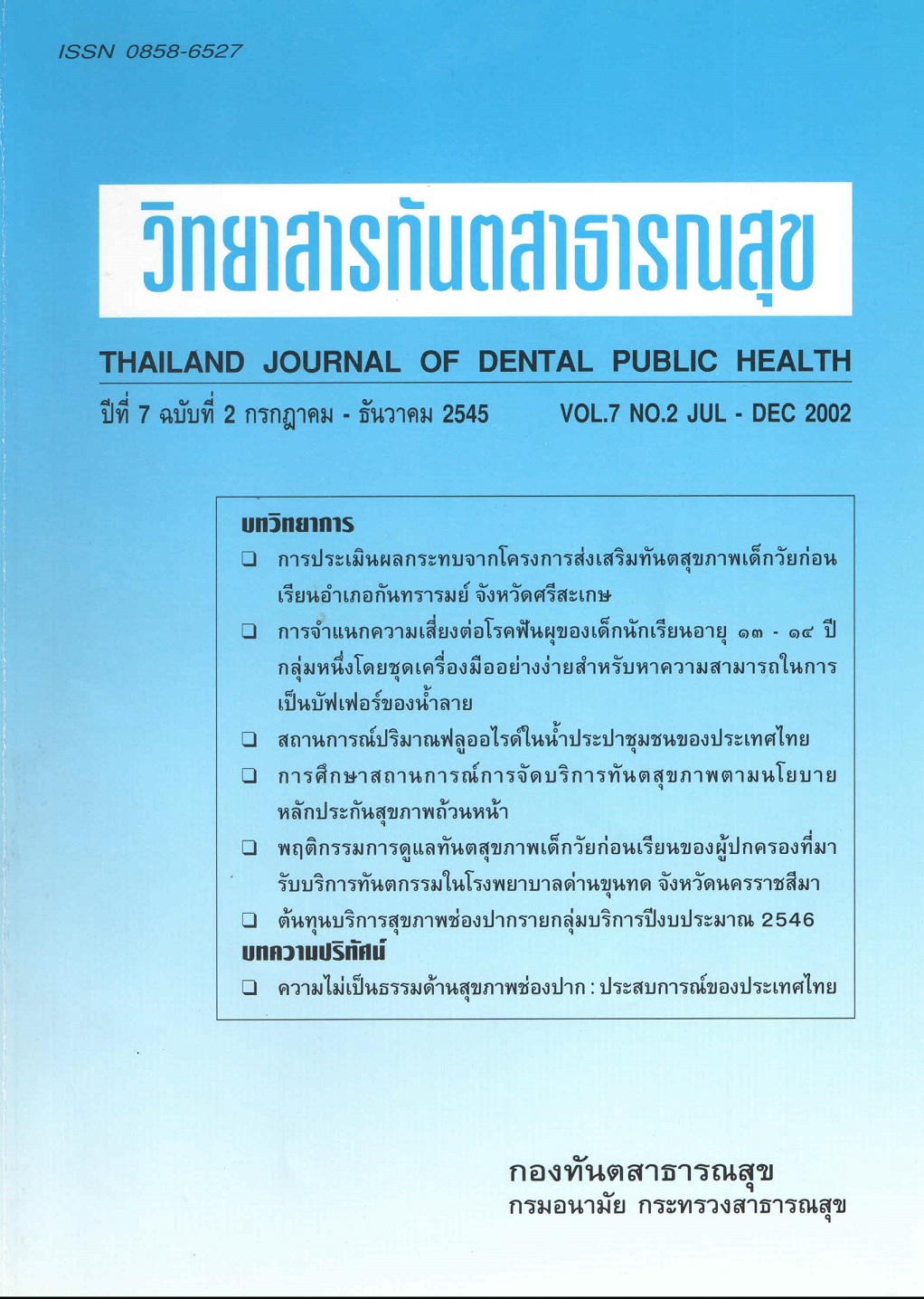The caries risk identification in a 13- to 14-year-old schoolchildren aroup by a simplified kit for salivary buffer capacity.
Main Article Content
Abstract
The salivary buffer capacity determination is a relevant index for a caries risk identification. Therefore some laboratory methods were developed to determine the buffer capacity conveniently. However, these methods required special equipment and the preparation of the kits were laborious. The objective of this study was to identify the caries risk in a population sample by a simplified kit which used aciddipped paper for titration for salivary buffer capacity determination. The population sample was 314; 13to 14-year-old students of a school in Bangkok. All subjects were healthy with no clinical sign of salivary gland abnormality. The DMFT were recorded, the stimulated saliva were collected and the salivary buffer capacity were determined by the simplified kit. The relationship between the level of salivary buffer capacity and the level of caries risk was analyzed by ANOVA. The contingency coefficient and the efficacy of the kit were calculated. The result showed that the group with low level of salivary buffer capacity had significantly higher DMFT than the other groups (p<0.05). The level of salivary buffer capacity was significantly correlated with the level of caries risk (p<0.05) with the contingency coefficient = 0.17. The simplified kit was capable to identify the high caries risk group with 37.5% sensitivity and 72.5% specificity. It was concluded that the salivary buffer capacity determined by the simplified kit could be a factor for caries risk identification in the population sample. Since the kit needed no laboratory equipment, it was available to be used in field study.
Downloads
Article Details
References
2. Turner NC, Scribner JH, Bell JT. The relationship of titratable acidity, titratable alkalinity and pH to the incidence of dental caries. J Dent Res 1954;33:55-61.
3. Ericsson Y. Clinical investigation of the salivary buffering action. Acta Odont Scand 1959;17:131 - 165. ก น
4. ยุทธนา ปัญญางาม, ดลฤดี แก้วสวาท, อรพินท์ อัจฉรานุกูล, การกําจัดน้ําตาลกลูโคสและคุณสมบัติความ เป็นบัฟเฟอร์ของน้ําลายในกลุ่มที่มีฟันผุมากและกลุ่มที่มีฟันผุน้อย, ว ทันต จุฬาฯ ๒๕๓๖,๑๑:๑๐๑-๑๑๐.
5. Frostell GA. A colourimetric screening test for evaluation of the buffer capacity of saliva. Swed Dent J 1980;4:81-86.
6. Wikner S, Nedlich U. A clinical evaluation of the ability of the Dentobuff method to estimate buffer capacity of saliva. Swed Dent J 1985;9:45-47.
7. Ericsson D, Bratthall B. Simplified method to estimate salivary buffer capacity. Scand J Dent Res 1989;97:405-40 7.
8. พรศรี ปฏิมานุเกษม, ยุทธนา ปัญญางาม, ระวีวรรณ ปัญญางาม. ชุดเครื่องมืออย่างง่ายสําหรับวัดความสามารถในการเป็นบัฟเฟอร์ของน้ําลาย. ว.ทันต.๒๕๔๕; ๕๒:๑๘๒-๑๙๑.
9. World Health Organization, Oral health survey basic method, WHO, Geneva 1977.
10. Marlay E. The relationship between dental caries and salivary properties at adolescence. Austral Dent J 1970;15:412-422.
11. World Health Organization, Oral health survey basic method, WHO, Geneva 1987.
12. ศรีสุดา ลีละศิธร, ปิยะดา ประเสริฐสม, อังศนา ฤทธิ์อยู่, ขนิษฐ์ รัตนรังสิมา สภาวะโรคฟันผุของประชาชนไทยและปัจจัยที่เกี่ยวข้องระหว่าง พ.ศ.๒๕๒๖-๒๕๔๐. ว ทันต สธ ๒๕๔๔๒ :๗ - ๒๓. 13. กานดา พูนลาภทวี, สถิติเพื่อการวิจัย พิมพ์ครั้งที่ ๑ กรุงเทพมหานคร เฟิสิกส์เซนเตอร์การพิมพ์;๒๕๓๐. หน้า ๑๑๑ และ ๒๔๗.

